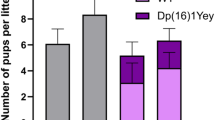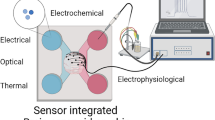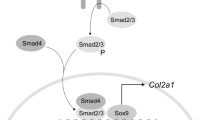Abstract
Small heat shock proteins (SHSPs) are conserved proteins that participate in many cellular functions like preventing protein aggregation and stress response. However, their role in responding to nanoparticles (NPs) has not yet been explained. We used a chicken embryo model to investigate the effects of two different forms of iron oxide-NPs (IONPs) on the mRNA expression of HSPB1, HSPB5, HSPB8, and HSPB9 in cerebral tissue. Two hundred-ten fertilized eggs were randomly divided into seven groups (30 eggs/group; 10 eggs/replicate). Three groups received 100 ppm, 250 ppm, and 500 ppm of Fe2O3-NPs, respectively. Three other groups received 100 ppm, 250 ppm, and 500 ppm of Fe3O4-NPs, respectively, and one group remained untreated as a control. The NPs were given by in ovo method (0.3 ml/egg) only once on the first day of the embryonic period. Samples from cerebrums were collected on day 20 for gene expression analyses. HSPB1, HSPB5, HSPB8, and HSPB9 were all expressed in both normal and IONPs exposed cerebrums. SHSPs tested were differentially expressed in response to various concentrations of IONPs. The highest expression levels in response to Fe2O3-NPs and Fe3O4-NPs were observed for HSPB5 and HSPB9, respectively. The greatest gene expression changes due to the Fe2O3-NPs and Fe3O4-NPs exposure observed for HSPB1 and HSPB5, respectively. The results suggest a protective cellular mechanism against IONPs through SHSPs and recommend that expression profiling of SHSPs be included in the study of nanotoxicity.



Similar content being viewed by others
Data Availability
The data are available from the corresponding author on reasonable request.
Code Availability
Not applicable.
References
Hwang YS, Ko MH, Kim YM, Park YH, Ono T, Han JY (2016) The avian-specific small heat shock protein HSP25 is a constitutive protector against environmental stresses during blastoderm dormancy. Sci Rep 6:36704
Bakthisaran R, Tangirala R, Rao CM (2015) Small heat shock proteins: role in cellular functions and pathology. Biochim Biophys Acta (BBA) Proteins Proteomics 1854(4):291–319
Reddy VS, Jamma T, Reddy GB (2020) Small heat shock proteins in inflammatory diseases
Mymrikov EV, Seit-Nebi AS, Gusev NB (2011) Large potentials of small heat shock proteins. Physiol Rev 91(4):1123–1159
Ramakrishna B, Mohan TCJBeba (2015) Small heat shock proteins: role in cellular functions and pathology
Heikkila JJ (2017) The expression and function of hsp30-like small heat shock protein genes in amphibians, birds, fish, and reptiles. Comp Biochem Physiol A: Mol Integr Physiol 203:179–192
Basaki M, Sahraiy N, Keykavusi K, Akbari G, Shahbazfar AA, Kianifard D (2020) Differential expression of small heat shock proteins in the brain of broiler embryo; the effects of embryonic thermal manipulation. J Therm Biol 93:102719
Malhotra N, Lee J-S, Liman RAD, Ruallo JMS, Villaflores OB, Ger T-R et al (2020) Potential toxicity of iron oxide magnetic nanoparticles: A review. Molecules 25(14):3159
Liu G, Gao J, Ai H, Chen X (2013) Applications and potential toxicity of magnetic iron oxide nanoparticles. Small 9(9–10):1533–1545
Hawse JR, Cumming JR, Oppermann B, Sheets NL, Reddy VN, Kantorow M (2003) Activation of metallothioneins and α-crystallin/sHSPs in human lens epithelial cells by specific metals and the metal content of aging clear human lenses. Invest Ophthalmol Vis Sci 44(2):672–679
Zheng S, Song H, Gao H, Liu C, Zhang Z, Fu J (2016) The antagonistic effect of selenium on lead-induced inflammatory factors and heat shock protein mRNA level in chicken cartilage tissue. Biol Trace Elem Res 173(1):177–184
Chen X, Zhu Y-H, Cheng X-Y, Zhang Z-W, Xu S-W (2012) The protection of selenium against cadmium-induced cytotoxicity via the heat shock protein pathway in chicken splenic lymphocytes. Molecules 17(12):14565–14572
Quraishe S, Asuni A, Boelens W, O’Connor V, Wyttenbach A (2008) Expression of the small heat shock protein family in the mouse CNS: differential anatomical and biochemical compartmentalization. Neuroscience 153(2):483–491
Webster JM, Darling AL, Uversky VN, Blair LJ (2019) Small heat shock proteins, big impact on protein aggregation in neurodegenerative disease. Front Pharmacol 10:1047
Franklin TB, Krueger-Naug A, Clarke D, Arrigo A-P, Currie R (2005) The role of heat shock proteins Hsp70 and Hsp27 in cellular protection of the central nervous system. Int J Hyperth 21(5):379–392
Tu W-L, Cheng C-Y, Wang S-H, Tang P-C, Chen C-F, Chen H-H et al (2016) Profiling of differential gene expression in the hypothalamus of broiler-type Taiwan country chickens in response to acute heat stress. Theriogenology 85(3):483–94 (e8)
Dimauro I, Antonioni A, Mercatelli N, Caporossi D (2018) The role of αB-crystallin in skeletal and cardiac muscle tissues. Cell Stress Chaperones 23(4):491–505
Arrigo A-P (2017) Mammalian HspB1 (Hsp27) is a molecular sensor linked to the physiology and environment of the cell. Cell Stress Chaperones 22(4):517–529
Muranova LK, Sudnitsyna MV, Strelkov SV, Gusev NB (2020) Mutations in HspB1 and hereditary neuropathies. Cell Stress Chaperones 25(4):655–665
Reddy VS, Pandarinath S, Archana M, Reddy GB Impact of chronic hyperglycemia on small heat shock proteins in diabetic rat brain. Arch Biochem Biophys 2021:108816
Bartelt-Kirbach B, Golenhofen N (2014) Reaction of small heat-shock proteins to different kinds of cellular stress in cultured rat hippocampal neurons. Cell Stress Chaperones 19(1):145–153
Sundarraj K, Raghunath A, Panneerselvam L, Perumal E (2017) Iron oxide nanoparticles modulate heat shock proteins and organ specific markers expression in mice male accessory organs. Toxicol Appl Pharmacol 317:12–24
Seidel K, Vinet J, den Dunnen WF, Brunt ER, Meister M, Boncoraglio A et al (2012) The HSPB8-BAG3 chaperone complex is upregulated in astrocytes in the human brain affected by protein aggregation diseases. Neuropathol Appl Neurobiol 38(1):39–53
Li F, Yang B, Li T, Gong X, Zhou F, Hu Z (2019) HSPB8 over-expression prevents disruption of blood–brain barrier by promoting autophagic flux after cerebral ischemia/reperfusion injury. J Neurochem 148(1):97–113
Laure L, Long R, Lizano P, Zini R, Berdeaux A, Depre C et al (2012) Cardiac H11 kinase/Hsp22 stimulates oxidative phosphorylation and modulates mitochondrial reactive oxygen species production: Involvement of a nitric oxide-dependent mechanism. Free Radical Biol Med 52(11–12):2168–2176
Lan Y, Wang Y, Huang K, Zeng Q (2020) Heat shock protein 22 attenuates doxorubicin-induced cardiotoxicity via regulating inflammation and apoptosis. Front Pharmacol 11:257
Wang S-H, Cheng C-Y, Tang P-C, Chen C-F, Chen H-H, Lee Y-P et al (2013) Differential gene expressions in testes of L2 strain Taiwan country chicken in response to acute heat stress. Theriogenology 79(2):374–82 (e7)
Luo Q, Song X, Ji C, Zhang X, Zhang D (2014) Exploring the molecular mechanism of acute heat stress exposure in broiler chickens using gene expression profiling. Gene 546(2):200–205
Wu W, Lai L, Xie M, Qiu H Insights of heat shock protein 22 in the cardiac protection against ischemic oxidative stress. Redox Biol 2020:101555
Budnar P, Singh NP, Rao CM (2021) HSPB5 (αB-crystallin) confers protection against paraquat-induced oxidative stress at the organismal level in a tissue-dependent manner. Cell Stress Chaperones 26(1):229–239
Fernández-Bertólez N, Costa C, Bessa MJ, Park M, Carriere M, Dussert F et al (2019) Assessment of oxidative damage induced by iron oxide nanoparticles on different nervous system cells. Mutation Research/Genetic Toxicology and Environmental Mutagenesis 845:402989
Basaki M, Keykavusi K, Sahraiy N, Ali Shahbazfar A (2021) Maternal exposure to iron oxide nanoparticles is associated with ferroptosis in the brain: a chicken embryo model analysis. J Anim Physiol Anim Nutr
Ahmad MF, Singh D, Taiyab A, Ramakrishna T, Raman B, Rao CM (2008) Selective Cu2+ binding, redox silencing, and cytoprotective effects of the small heat shock proteins αA-and αB-crystallin. J Mol Biol 382(3):812–824
Asthana A, Bollapalli M, Tangirala R, Bakthisaran R, Rao CM (2014) Hsp27 suppresses the Cu2+-induced amyloidogenicity, redox activity, and cytotoxicity of α-synuclein by metal ion stripping. Free Radical Biol Med 72:176–190
Masilamoni JG, Jesudason EP, Bharathi SN, Jayakumar R (2005) The protective effect of α-crystallin against acute inflammation in mice. Biochim Biophys Acta (BBA) Mol Basis Dis 1740(3):411–20
Bi X, Jiang B, Zhou J, Luo L, Yin Z (2020) Phosphorylated Hsp27 prevents LPS-induced excessive inflammation in THP-1 cells via suppressing ROS-mediated upregulation of CBP. Cell Biol Int 44(1):253–267
Behdarvandy M, Karimian M, Atlasi MA, Azami TA (2020) Heat shock protein 27 as a neuroprotective biomarker and a suitable target for stem cell therapy and pharmacotherapy in ischemic stroke. Cell Biol Int 44(2):356–367
Oberdörster G, Kuhlbusch TA (2018) In vivo effects: Methodologies and biokinetics of inhaled nanomaterials. NanoImpact 10:38–60
Funding
This work was funded by the University of Tabriz [grant number 4305968892].
Author information
Authors and Affiliations
Contributions
Optional: please review the submission guidelines from the journal whether statements are mandatory.
Corresponding author
Ethics declarations
Ethics Approval
All experiments were done according to the Guide for the Care and Use of Laboratory Animals by the National Academy of Sciences (National Institutes of Health publication No. 86–23) and after institutional approval of the bioethics committee of the University of Tabriz.
Consent to Participate
Not applicable.
Consent for Publication
All authors have read the manuscript and agree to submit the manuscript to this journal.
Conflicts of Interest
There are no conflicts of interest.
Additional information
Publisher's Note
Springer Nature remains neutral with regard to jurisdictional claims in published maps and institutional affiliations.
Rights and permissions
About this article
Cite this article
Basaki, M., Keykavusi, K., Sahraiy, N. et al. Small Heat Shock Protein’s Gene Expression Response to Iron Oxide Nanoparticles in the Brain. Biol Trace Elem Res 200, 1791–1798 (2022). https://doi.org/10.1007/s12011-021-02761-8
Received:
Accepted:
Published:
Issue Date:
DOI: https://doi.org/10.1007/s12011-021-02761-8




